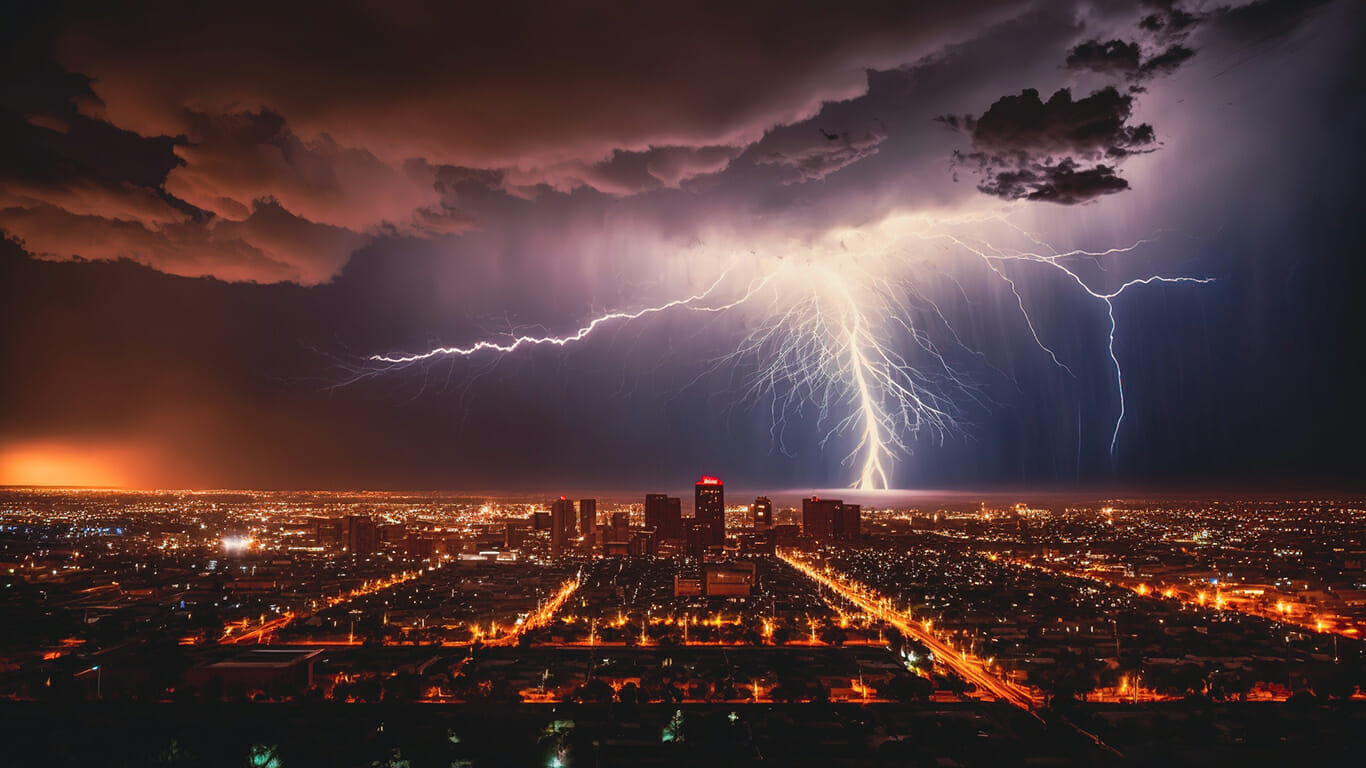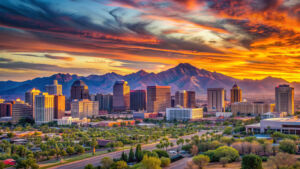Discussing the weather and monsoon season is small talk for most of us.
But ask Erinanne Saffell her thoughts on the topic and you may be flooded with details about everything from the drought to dust storms.
Saffell is the Arizona state climatologist and an associate teaching professor at Arizona State University’s School of Geographical Sciences and Urban Planning.
LOCAL NEWS: 100 best places to work and live in Arizona for 2025
INDUSTRY INSIGHTS: Want more news like this? Get our free newsletter here
From her office in the Walton Center for Planetary Health, the Global Futures scientist follows the atmosphere through weather models, real-time online weather observations, radar and satellite. And the five large windows in her office provide a perfect place for weather watching.
On the ground, she uses hundreds of weather stations across the state to track dangerous heat conditions.
And while people typically slow down during the summer, things heat up for Saffell, as she follows flash floods, thunderstorms and other weather patterns that are less predictable than the sunny days that dominate most of the year.
“It’s thrilling to be able to serve the state I was born in by helping communities, agencies and the public understand Arizona’s weather and climate,” said Saffell, who earned a bachelor’s, master’s and doctoral degree in geography from ASU.

ASU News recently spoke with Saffell about her summer forecast and how she and her staff plan to weather the season.
Note: This interview has been lightly edited for length, grammar and/or clarity.
Question: While people are winding down during the summer, you are entering your busy season. What are summers like for Arizona’s state climatologist?
Answer: One of the more exciting times of year is the monsoon season. It’s almost like following a sports game because you might be familiar with the players and think you know the outcomes, but there are always uncertain factors. When you watch cumulus clouds form in the summer, you can see the clouds getting bigger and taller in the sky. Will there be enough of all the ingredients in the right location to drop rain out of the sky? That’s what we watch for!
Every summer is different, but I start paying close attention to the atmospheric thunderstorm ingredients in April and May. If everything works perfectly, Arizona can start seeing thunderstorms in late June or early July. The monsoon season is usually initiated by an area of high pressure over the Four Corners region. It helps pull moisture into the state that can trigger monsoon thunderstorms.
Q: Summers seem to be getting longer and hotter and hotter for longer periods of time. Will we be breaking last year’s records?
A: Statewide, 2024 ended with the 16th driest and the overall hottest summer on record (June to September) with a record total of 39 nights that didn’t cool off below 90 degrees Fahrenheit.

From Sept. 24 to Oct. 14, 2024, a very strong heat wave broke temperature records not only in Arizona but across the Southwest. Arizona set a record for the latest 113 F temperature ever recorded for Phoenix (Oct. 6, 2024). Most 110 F or higher temperatures usually end by mid-September. Fortunately, not every weather record gets broken every year.
A few outlooks are hinting that Arizona might have a wetter monsoon this summer. For the monsoon to start, we pay attention to an area of high pressure called the Monsoon Ridge. Some ingredients that help build the Monsoon Ridge include dry soil moisture after a dry summer and fall, and a dry winter without a lot of snowpack. A lot of these ingredients are in place but we’ll still have to wait and see what happens.
Q: What are your predictions for other summer weather conditions during the monsoon?
A: While some monsoon seasons are more active than others, every summer brings the possibility of dangerous weather across the state. Wildfire activity is often more prominent early in the monsoon season, but wildfire activity can persist during a dry summer. Lightning is the main ignition for wildfires in June. “Dry lightning” is when a thunderstorm could spark ignition yet produce little rainfall, potentially allowing a wildfire to build. Statistically, four people die every year in Arizona from flooding. Sadly, there were two flooding fatalities in Arizona in 2024. Damaging winds and hail are always possible from summer thunderstorms, as are strong downbursts. Dust storms can deliver decreased visibility and poor air quality.
Can everyone know exactly where and when these dangerous conditions will happen? Most Arizonans have experienced a summer where they got clobbered with a strong thunderstorm while their neighbor down the street stayed dry. That’s the nature of Arizona’s convective thunderstorms. Every monsoon season is different, but the potential for dangerous weather happens every summer.
Q: One of your many roles as Arizona state climatologist is to examine historical climate data. What does that entail?
A: I enjoy digging into Arizona’s weather records; they go back over 150 years. Some of the older weather records are only available in my office because the paper is fragile and can’t be digitized. The penmanship is exceptional! We have old newspaper articles from the early 1900s, too. The articles are engaging, fascinating and detailed; people in the early 1900s were just as interested in weather as we are today.
Q: Lastly, any recommendations for keeping Phoenix residents cool during the summer — besides heading for the coast?
A: Arizonans definitely take advantage of the cooler parts of the state during summer, like Flagstaff, Prescott, Payson and Show Low. The Mogollon Rim is also a favorite camping area. Summer thunderstorms usually happen earlier in the afternoon at these higher elevations and can quickly drop hail, lightning and a lot of rain. When hiking or camping this summer, it’s important to plan for the weather.




